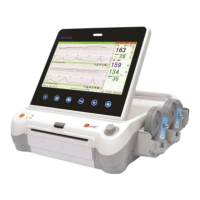S
S
S
R
R
R
F
F
F
6
6
6
1
1
1
8
8
8
B
B
B
6
6
6
U
U
U
s
s
s
e
e
e
r
r
r
’
’
’
s
s
s
M
M
M
a
a
a
n
n
n
u
u
u
a
a
a
l
l
l
~15~
When the battery configuration is provided, after the device is transported or stored, the battery must be
charged. Connecting to power supply will charge the battery no matter if the monitor is powered on.
3.3 Installation
The monitor can be placed on a flat surface, or be installed on a wall or a trolley. The service engineer should
install the monitor properly.
NOTE:
When you use this instrument you shall keep a certain distance (more than 300mm) away from other
equipment around, so as to ensure the convenience and safety of the use of this instrument.
3.4 Connecting Power Cable
1) Make sure the AC power supply of the monitor complies with the following specification: 100V-240V,
50Hz/60Hz.
2) Apply the power cable provided with the monitor. Plug one end of the power cable to the power socket
of the monitor. Connect the other end to a three-slot power output special for hospital usage.
3) The equipotential grounding terminal is provided for the connection of a potential equalization
conductor. Therefore, it is recommended to connect the grounding terminal of the monitor and the
power outlet with the grounding wire, making sure the monitor is grounded.
WARNING:
If the protective grounding (protective earth) system is doubtful, the power of the monitor must be supplied
by inner power only.
NOTE:
1) Make sure the monitor and the power outlet are placed at a place where it is easy to connect and
disconnect the power cord.
2) When the supply mains is interrupted, the device switches to inner power and operates normally if the
battery is installed. If the battery is not installed, the monitor shuts down and resumes the previous
settings at the subsequent operation.

